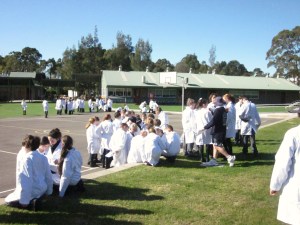Building the Education Revolution Spaces
International readers, the background to this post is a huge financial investment by the Australian government in new school capital works progams as one of several initiatives to counteract the effects of the Global Financial Crisis. The investment was called "Building the Education Revolution" (B.E.R.).
Here's a video from Balwyn Primary school in Victoria:
The video appears to be published by 'Furnware', a furniture company, but the link at the end of the video goes to the Victorian education website on the B.E.R. There are links from there to standard templates for schools. I can't really tell from the templates if they're any good, but there are some good signs. The dot points on a typical template seem to be on the right track, as does this video with key architects. They really emphasise the adaptability of the buildings to future changes. The thinking is spot on.
I'd love to hear from Victorian colleague about the templates. I'm not exactly bowled over by video footage of a range of spaces but it looks like there's some good stuff in the mix. (Me, the measure of all things, of course!)
Footage from the New South Wales Department of Education and Training, unfortunately, is another matter.
Here's an overview of one of their templates:
The concept of 'computer nooks', is of course dead in the water. That's why you soft-code your spaces. "Team-teaching" is the closest we get to innovation in the NSW video, which isn't very close at all I'm afraid. If I'm depressed by the end of it, this second overview doesn't cheer me up:
There's a complete absence of vision for what is the chance of a generation.
I beg of readers to correct me or add information in the comments. Maybe the Victorian PR machine is just better?
One thing I landed on for NSW was these reports.
In this interim report (warning - it's a 10mb Word doc), page 54, we read:
The managing contractors engaged by NSW adopted existing concept design templates developed for NSW DET and prepared these designs for construction. These design templates developed by managing contractors were used in 97 per cent of NSW Government school P21 projects. In some instances the design templates were not well suited to schools with space constraints. This was observed by the Taskforce in inner-city areas
I gather, from this, that 97% of participating NSW government schools had template buildings that were already kicking around the D.E.T. when the funding program was launched.
In Victoria, on the other hand:
The Victorian Government recently developed a suite of design templates for new school buildings in accordance with that state’s Victorian Schools Plan. The Program has provided the Victorian DEECD with an opportunity to accelerate its state-wide roll out of new learning facilities and apply the new design templates. The Taskforce observed the Victorian Government design templates to be of high quality. The template development was hastened to take advantage of the Program and in some instances the designs have yet to benefit from feedback from earlier projects.
However, nationally:
Design templates were not used by the majority of non-government schools.
The Victorian videos inspired me, expecially the first one.
The NSW one, however, made me feel I was back in the 1980s. It worries me, the cultural inertia that spaces carry with them, and therefore the braking effect the BER investment has the potential to cause on the learning paradigm-shift we so desperately need.


